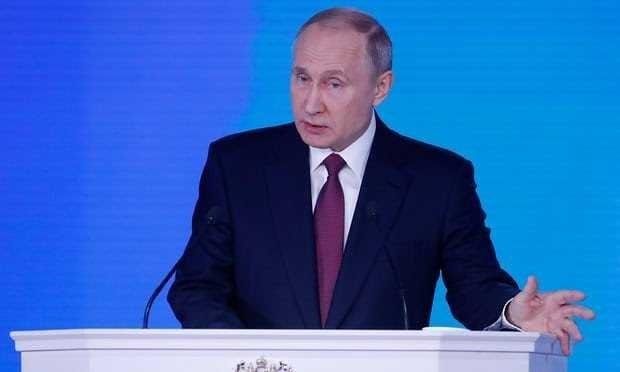Vladimir Putin threatens US arms race with new missiles announcement

Vladimir Putin has announced that Russia has developed and is testing a new line of strategic, nuclear-capable weapons that would be able to outmanoeuvre US antiballistic missile defences, suggesting a new arms race between Moscow and the west.
Speaking in a nationally televised address to Russia’s political elite, the president showed both video and animation of Russian ICBMs, nuclear-powered cruise missiles, underwater drones, and other weapons that he said Russia had developed as a result of the US pulling out of the 1972 antiballistic missile treaty signed with the Soviet Union.
“You didn’t listen to our country then,” Putin said during the speech on Thursday, where he said that some of the weapons were already being tested. “Listen to us now.”
The speech came in the same month that the Pentagon released a new nuclear arms policy, which followed on from a promise by the US president, Donald Trump, to develop an arsenal “so strong and powerful that it will deter any acts of aggression”. The policy envisioned low-yield nuclear weapons on submarine-launched ballistic missiles, that could counter similar Russian weapons.
In the speech, Putin issued a message of defiance, saying: “I would like to tell those who have been trying to escalate the arms race for the past 15 years, to gain unilateral advantages over Russia, and to impose restrictions and sanctions ... The attempt at curbing Russia has failed.”
Putin’s remarks came during a state of the union speech heavy on economic promises for the Russian people and sabre-rattling against the United States. The presentation was widely viewed as his first stump speech for Russia’s 18 March presidential elections. The Kremlin is primarily concerned with boosting turnout as Putin is expected to cruise to a fourth term as president.
There were signs that the Kremlin wanted to attract extra attention to the speech by moving it from the gilded St George’s Hall at the Kremlin to an exhibition space in downtown Moscow, where video and infographics could be shown.
The first hour of the speech was conventional, if optimistic: Putin promised to raise life expectancy by 10 years, to raise Russia’s GDP by 50% by 2025, and to cut the rate of poverty among Russians by half.
During the speech, Putin said that Russia would have to latch on to a wave of technological advances or risk “drowning in that wave”.
While the interactive portion of address began with graphs showing Russian birth rates and harvest totals in recent years, it was mainly used as a platform to show off Russia’s latest weaponry, some of it capable of delivering a nuclear strike anywhere in the world.
Putin highlighted a test of Russia’s RS-28 Sarmat missile, an ICBM that, according to Russian state media, can fly 6,800 miles with a payload of 15 warheads (the actual capabilities of the missile have not been shown). The Russian defence ministry said it had held a successful test launch of the missile in October, saying it had traveled 3,600 miles before hitting a target area in Russia’s far east.
Putin also said during the speech that Russia had developed a working laser weapon, a hypersonic missile, and a cruise missile powered by a nuclear reactor that could fly “indefinitely”.
Putin has given the constitutionally mandated speech on “the situation in the country” 14 times since he first became president in 2000 (he did not give the address during the four years he was prime minister).
Putin’s address, which generally lasts around an hour, is given to an audience of lawmakers from the tate Duma and Federation Council, judges, ministers and other members of the political establishment, and generally focuses on domestic issues like the economy and the fight against corruption.